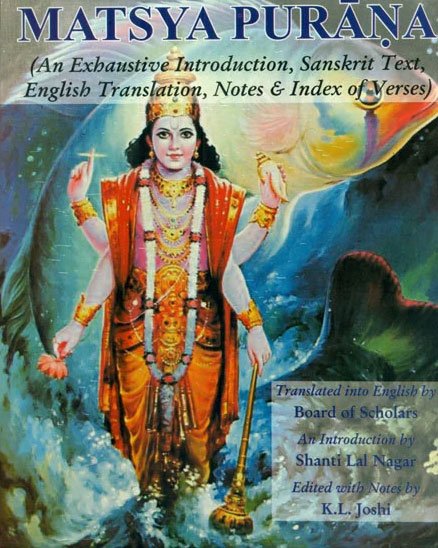The Matsya Purana (critical study)
by Kushal Kalita | 2018 | 74,766 words | ISBN-13: 9788171103058
This page relates ‘Shivacaturdashi-vrata’ of the English study on the Matsya-purana: a Sanskrit text preserving ancient Indian traditions and legends written in over 14,000 metrical verses. In this study, the background and content of the Matsyapurana is outlined against the cultural history of ancient India in terms of religion, politics, geography and architectural aspects. It shows how the encyclopedic character causes the text to deal with almost all the aspects of human civilization.
Part 4.2b - Śivacaturdaśī-vrata
This vrata as the name suggests is observed for propitiating Śiva for the welfare of the devotee. Hence this vrata is also known as Māheśvaravrata. In the 95th Chapter of the Matsyapurāṇa, Nandikeśvara, the chief attendant of Lord Śiva tells Nārada about the Śivacaturdaśīvrata. This varta is observed on the 14th day (caturdaśī) of bright fortnight in the month of Mārgaśīrṣā (Nov-Dec).[1] This vrata is regarded as the giver of happiness and emancipation. It is so effective that it washes away the sin of killing of brāhmaṇa and also the sins committed against parents, brothers etc.[2] The devotee gets long life, good health and prosperity by observing this vrata.[3] The woman who observes it taking permission of her husband or son or the preceptor attains bliss by the grace of Śiva.185 This vrata is regarded as equal to a thousand Aśvamedha.[4]
The Matsyapurāṇa describes the procedure of this vrata thus:
The devotee who wants to observe this vrata, should take meal once and pray to Lord Śiva with the sankalpa of Śivacaturdaśīvarta, on the day prior to the caturdaśī, i.e. on the 13th day.
He takes the vow with these words
“O Lord of All deities! I take refuge in thee. Tommorow, the caturdaśī day, I shall take a complete fast without eating anything and worship Śiva. I shall give away a bull, made of gold and then take my meals the next day”[5]
On the next morning, i.e. on the caturdaśī day the devotee worships lord Śiva and his consort Umā with white lotus, garlands, sandal paste etc. Different mantras are recited in connection with the different limbs of Śiva.The feet of the lord is worshipped after reciting the mantra śivāya namaḥ, the head is worshipped with the mantra sarvātmane namaḥ, the eyes, with the chanting of trinetrāya namaḥ etc.[6] Then a bull made of gold is to be given to the brāhmaṇa along with a pitcher which is full of water, covered with white garments, five jewels, and various kinds of eatables.[7] The devotee should eat ghee mixed with coagulated milk and sleep on the ground. Next day after worshipping the brāhmaṇas he should take food. The worship is performed in the same way on all the 14th days of each fortnight of every month for twelve months.
Special mantras are recited for commencing with the month Mārgaśirā starting with śaṃkarāya namaḥ. Other names of Śiva which are uttered in the mantras are: Karavīraka, Tryambaka, Maheśvara, Mahādeva, Sthānu, Paśupati, Nātha, Śambhu, Paramānanda, Somārdhadhārin and Bhauma.[8]
Thereafter pancagavya consisting with cow’s urine, cow-dung, milk, curds and clarified butter, water mixed with kuśa grass, wood apple, camphor, agaru, barley, black sesame and long pepper are offered to Śiva as prāśana (food).[9] These are offered to Śiva one by one on the caturdaśī day of each month. Similarly Śiva is offered one type of flower every month. The Flowers are: mandāra, jasmine, dhatūrā, sambhālū, aśoka, mallikā, kadamba, śatapatrī and kamala.[10] Again in the month of Kārtika, the devotee should feed Brāhmaṇas with various kinds of food and offer garments, ornaments and garlands. As words given in sankalpa the devotee gives a black bull as gift with Vedic rites. And then he gives away a bull and a cow along with a golden image of Śiva and Pārvatī. A bedstead, along with eight pearls, sheets, pillows and vase are also given away to the brāhmaṇa who is acquainted with the Sāmaveda.[11] The Matsyapurāṇa also enjoins that gifts should be given to a brāhmaṇa who is not a widower, who is of good conduct and who is not of defective limbs. If the preceptor of the devotee is present, then the gifts should be given to him only. In this way the Matsyapurāṇa describes the Śivacaturdaśīvrata.
The Agnipurāṇa deals with a vrata which is very similar to Śivacaturdaśīvrata. This is termed as Phalacaturdaśīvrata. This vrata is also observed for getting happiness and emancipation. It is observed on the 3rd, 8th, 12th or 14th day of the bright fortnight in the month of Mārgaśirā. The devotee lives only on fruits and worships lord Śiva. And then fruits are given as gifts to the brāhmaṇa.[12]
Again the Liṅgapurāṇa deals with a similar vrata which is observed in the month of Pauśa. The devotee lives only on nākta taking food of wheat, rice and milk only.This vrata is observed till the month of Mārgaśirā for one year.[13]
A vow called Śivarātrivrata is observed even today in Assam, Bengal, Odisha and other parts of India. This is observed on the 14th day of the dark fortnight of Māgha or Phālguna. This vrata, though performed on the caturdaśī day and dedicated to Śiva is different from Śivacaturdaśīvrata mentioned in the Matsyapurāṇa.
Footnotes and references:
[1]:
Cf., Matsyapurāṇa, 95.5-6
[2]:
brahmahatyādikaṃ kiñcidyadatrāmutra vā kṛtam / pitṛbhirbhrātṛbhirvāpi tatsarvaṃ nāśamāpnuyāt// Ibid., 95.33
[3]:
[4]:
Ibid., 95.32
[5]:
[6]:
Ibid., 95.9-13
[7]:
tatastu vṛsabhaṃ haimamudakumbhasamanvitam/ śuklamālyāmbaradharam pañcaratnasamanvitam/bhakṣyairnānāvidhairyuktam brāhmaṇāya nivedayet// Ibid., 95.14
[8]:
Ibid., 95.18-22
[9]:
Ibid., 95.21-22
[10]:
arkapuṣpaiḥ kadambaiśca śatapatrya tathotpalaiḥ/ ekaikena caturdaśyorarcayet pārvatīpatim// Ibid., 95.24
[11]:
Cf., kṛtvā nīlavṛṣotsargaṃ śrutyukta vidhinā naraḥ / umāmaheśvaraṃ haimaṃvṛsabhañca gavā saha// muktāphalāṣṭakayutāṃ sitanetrapaṭāvṛtām/ sarvopaskarasaṃyuktāṃ śayyāṃ dadyāt sakumbhakām// Ibid., 95.26-27
[12]:
Agnipurāṇa. 192.2-3
[13]:
Liṅgapurāṇa, 83.13.54
